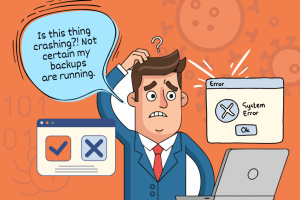With an increasing amount of people and industries relying on computer systems to function, computer failure can be devastating. From lost time to lost data, its effects can be very impactful! Thankfully, many computer system malfunctions can help mitigate or even protect you from the impact of a system failure.
systems are stored and used in can cause a failure if it’s not appropriate for the hardware.
Computer systems don’t operate well in the presence of a lot of heat. Cooling systems can help with this issue; However, computers make their own heat. As such, the temperature that works best for a computer may conflict with the temperature preferred by people. Another factor to consider is voltage amount. Despite using electricity to function, computer systems are sensitive to the amount of electricity they receive. Voltage spikes, like in thunderstorms, can damage computers. A simple way to mitigate this is utilizing a surge protector — they help regulate the electricity to prevent a dangerous spike in voltage.
Over time, computer parts eventually fail. Some common parts that can break are fans, hard disk drives, CPUs, and GPUs. A great resource to use for checking the health of many computer parts is through Windows’ Built-in Performance Monitor Tool. One way to launch the program is to open the Start menu, search for its name, and click on the link to open the app. You may have to wait for a few seconds while the app collects data. When finished, this tool will provide you with multiple checks for your hardware, software, CPU, network, disk, and memory, along with a long list of detailed statistics. Use it to determine unusual behavior and whether it’s time to replace a part.
Due to the nature of technology, updates are integral to computer software. Usually, regularly updating software ensures trouble-free use, good performance, and less problems. Despite this, you may encounter other issues or changes that can be problematic in an update. When this occurs, evaluate your options, risks on both versions, and make a decision to stick with either the new version or revert to the older version.
While it may be fine in the short term, the longer the software is outdated, the more likely other issues may arise. Thus, it may be wise to eventually update to the latest version or to create multiple different backups of your data and software. While Operating Systems may have different names for their built-in backup software, they can all be useful in recovering from such incidents.
Malware is a catch-all term for any type of malicious software, regardless of how it works, its intent, or how it’s distributed. If you suspect one of your devices is infected with malware, it is crucial to clean up the affected programs, repair any affected files, and then implement preventative measures. A useful built-in tool Windows 10 is Windows Security; this can provide real-time protection against malware by running a scan to detect suspicious programs and take appropriate action.
Computers are steadily becoming more essential to the modern world. Whether you are in a home, small office, or a large corporation, putting safeguards to protect your system protects you from potentially devastating losses. Despite this, one of the main reasons computer systems fail is due to human error. Even when you have safety precautions in place, protocols must be followed. Taking the time to educate yourself or others on what they should do is incredibly valuable and worthwhile in the long run.




